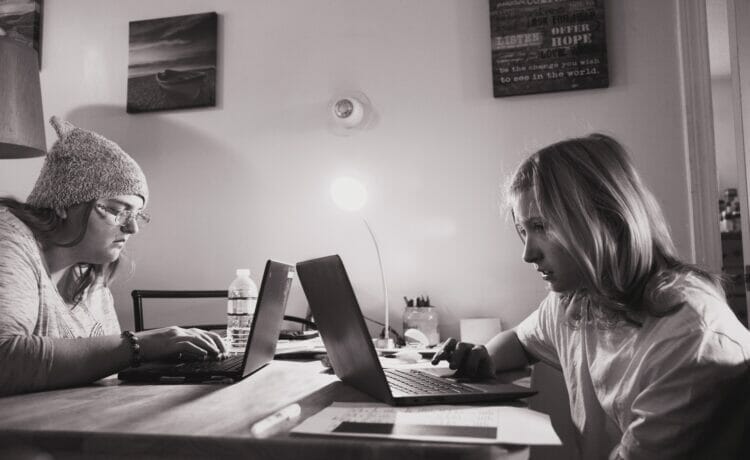
Transitioning to Remote Learning
This year, many students and their families have lost the ability to choose how they would like their education structured. Instead, most students are required to attend remotely, in virtual classrooms with other online students, whether or not the environment suits their learning needs. Districts, schools, and teachers are all doing their best to create an online experience that will benefit their students, but as everyone knows by now, classrooms designed by Covid-19 are not working for all.
Luckily, we have found that remote learning in a personalized program and a 1-on-1 teacher (via Zoom or other platform) can make all the difference. Cameras are on, connections are made, and each lesson adjusts to the student’s mood and capacity to learn that day. A warm, knowledgeable teacher also makes all the difference, and the Academy guarantees that in addition to know-how, instructors are able to establish supportive rapport with their students. When students are engaged, they can focus. When they can focus, they can make their way through the curriculum and prove their mastery at a much faster pace than a typical classroom (even pre-Covid).
If you believe that flexible, one-on-one classes or tutoring could be beneficial for your student, please reach out to us through the Let’s Talk Form on our website. Helping students learn the way they learn best is what we do, even if we have to do it remotely, or rather, Remote-Plus!
Remote Learning Challenges and Solutions:
Despite the magic of 1-on-1 education, there are some challenges to working remotely. Here are some of the biggest difficulties we have experienced and suggestions for minimizing their negative effects.
1. Being online is tiring.
Students who are already taking a full or partial load at a typical school will find they put in 3-5 hours on a computer before they even start their homework. Virtual communication can drain you, despite the comfort of being at home, wearing your bunny slippers and pajamas.
Our Solution: Academy students typically see us twice a week for an hour lesson each time. Even this college-like schedule leads to finishing a credit course quickly, typically in 1/3 the time it takes in a regular classroom. Students have more time to recharge between lessons, and, since courses are naturally accelerated, that means less time spent on the computer overall!
2. School is literally everywhere.
If your classroom is in your bedroom, at your kitchen table or on your living room couch, it’s hard to leave school when you’re ready for a brain break. Did you have a tough time with Math in the living room earlier today? It’s harder still to relax on the same couch later because now it’s associated with school work.
Our Solution: We recommend finding ONE place in the house to do all your school work so that when you get up and walk away, you’re truly leaving school and getting the rest and relaxation you need. A clear, uncluttered desk area can bring peace to an overwhelmed mind, and knowing that ONE spot is where you study can signal to your brain that it’s time to focus.
3. Social interaction is at a minimum.
Despite seeing your Academy teacher’s smiling face, the lack of interaction with other students can be tough. Most of the country is feeling isolated right now, which extends to a sense of losing connection in a place we’re used to seeing friends, at school.
Our Solution: For those not leaving their house, be sure to schedule virtual “hang out” time, making sure to schedule remote chats with people you like and love. You don’t have to just stare into each other’s eyes! Try some online games, from virtual cards to trivia. One of our instructors convinced me to use Jackbox at our staff meeting and we loved it! Dance parties just need music (in Zoom, go to share screen and click on the “share audio” button), and even just casually talking while you clean your room gives a nice sense of togetherness.
In the “outside world,” some families go hiking or biking with friends, staying socially distanced and with a mask on, but still seeing their friends in real life. I remember seeing a friend of mine in the grocery store parking lot a few months after Covid started and it was such a thrill to have that social energy pass through us, even at 10 feet away!
4. Confusion can stick if no one is around to help.
Students who are struggling with an assignment won’t necessarily have the same daily access to their classroom teachers that they enjoyed pre-COVID. While this isn’t the case with a Pacific Learning Academy accredited course, most of our students are also taking classes at their local high school (virtually).
Our Solution: Be sure to note teacher virtual office hours and utilize any and all offers for help via email or outside the regular learning time. Classroom teachers are truly working SO HARD to accommodate their students. We know better than anyone what a difference some one-on-one time makes, and the more intentional students are about seeking that out, the better. When your classroom teacher’s availability is less than what your student needs, we recommend talking to your Academy Academic Coordinator about taking the class with us, where one-on-one attention is the norm, not the exception.
Pacific Learning Academy is a one-on-one school offering single courses and dual enrollment, as well as full-time middle and high school. Pacific Learning Academy is Washington State Approved via the Office of Superintendent of Public Instruction (OSPI — see listings HERE) and a nationally Accredited private school via AdvancED/Northwest Accreditation Commission (NWAC). High School coursework is approved by the National Collegiate Athletic Association (NCAA). We also offer tutoring in all subjects from 6th to 12th grade, including test prep, either in-home or local libraries across the Eastside (Issaquah, Sammamish, etc…). See more at www.PacificLearningAcademy.com
